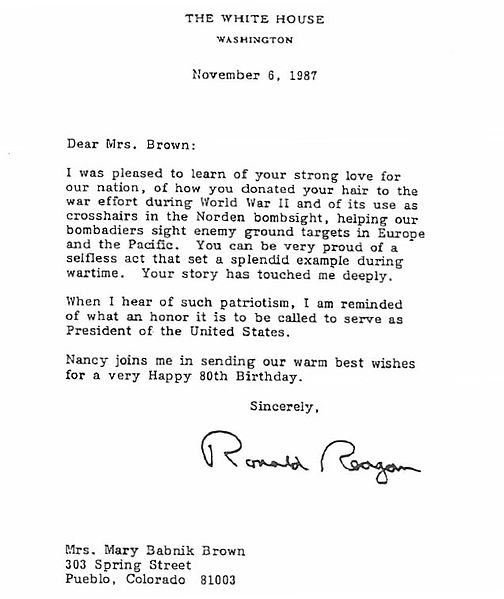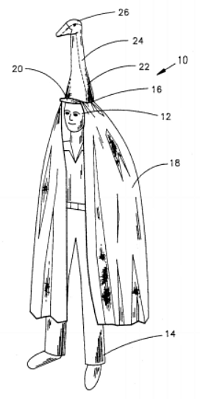
Patented in 1993, Raymond Norris’ “combined camouflage and decoy device” is pretty straightforward: You wear a cap that supports an artificial head (to attract birds) and a cape (to hide you from them).
Just hope it doesn’t attract giant geese.

Patented in 1993, Raymond Norris’ “combined camouflage and decoy device” is pretty straightforward: You wear a cap that supports an artificial head (to attract birds) and a cape (to hide you from them).
Just hope it doesn’t attract giant geese.

Patented in 1914, Socrates Scholfield’s “illustrative educational device” uses two spiral springs to demonstrate the existence of God. Or to demonstrate the tension between good and evil. Or to demonstrate the consciousness of an animal organism. Actually I’m not sure what it demonstrates, and I’ve read the five-page abstract twice.
This schematic device … provides an educational emblem of the conscious relation that must exist between the co-extensive dispensing mediums for beneficence and maleficence, in the terrestrial factory; and it clearly indicates that the attribute of maleficence, which is ascribed to the realm of the adverse medium, may, under certain changed conditions, be made subject to decrease, and to a change in its relative action; while the attribute of beneficence, which pertains to the realm of the controlling supreme governor, is unconditioned, unchangeable and everlasting.
Here’s the whole thing if you want to try it out. Be careful, I guess.
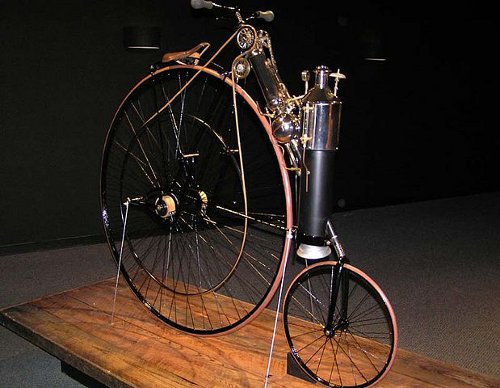
Visitors to Arizona’s Maricopa County Fair saw a surprising demonstration in 1884 — local inventor Lucius Copeland had added a steam engine to a bicycle to create a new vehicle that could travel 15 miles in an hour.
He sought funding for his idea but couldn’t summon enough public interest. It’s now recognized as one of the first motorcycles.
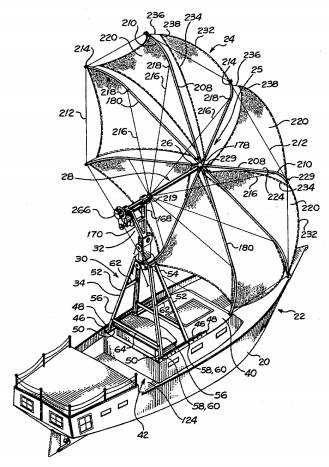
Peter Krovina’s “sailing system,” patented in 1981, replaces a conventional sail with an adjustable windmill — while it’s driving the boat forward, it’s also storing power in batteries.
The batteries serve the boat’s need for electricity, powering the running lights, the cabin lights, space heaters, and the cooking stove.
Best of all, they eliminate the need for an engine — an electric motor drives the screw.
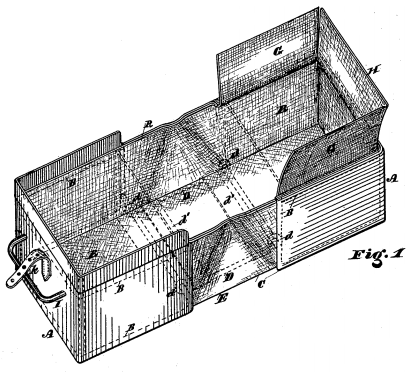
This is admirably simple: In 1876 Ethelbert Watts invented a portmanteau that doubles as a bathtub:
“The object of my invention is to provide a portmanteau, valise, traveling-bag, or other equivalent article used for the transportation of clothing, which shall be convertible into a bath-tub, so as to afford travelers in places where such conveniences are wanting the luxury or comfort of bodily ablution.
“Articles of clothing, &c., may be packed and carried in it as in any portmanteau or equivalent device. When it is desired to use it as a bath-tub the portmanteau is opened, as shown in Fig. 1, and the contents removed. Water is then poured in, when a bath may be enjoyed, as in a permanent tub or fixture. When the bath is over, the water is poured or dipped out, the interior dried by any suitable means, and the device is again ready for use as a portmanteau.”
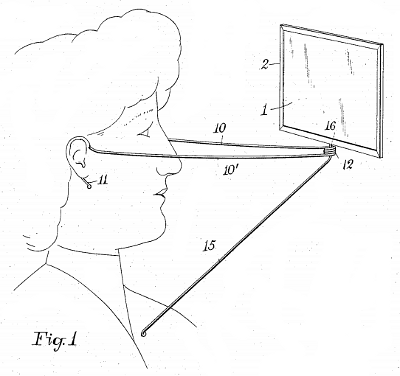
In 1904 Emmie Alice Thayer lamented that a lady had to hold a hand mirror while attending to her hair or addressing the fit of her garment. The answer, she decided, was to wear the mirror by attaching it to her ears. Kudos.
In the same vein, in 1950 John Kozloff invented a “mirror-attached spectacle frame” (below) to free one’s hands for applying cosmetics or shaving. If you’re nearsighted they can even be fitted with glasses. With a pair of these Narcissus wouldn’t have been tied to that boring pool …
See Self-Regard.
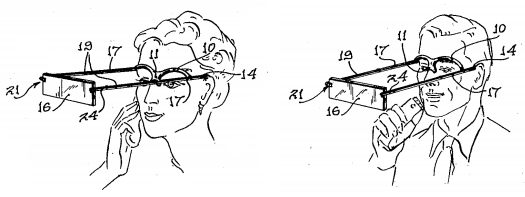
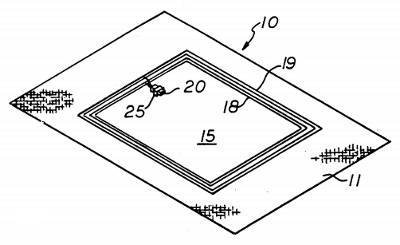
Here’s one way to prevent ants from ruining your picnic — surround the tablecloth with parallel strips of electrically conductive material and attach them to a DC battery. Now any bug that crosses the border will close the circuit and get “a sensation which will discourage further travel across the edge of the cloth.” (Humans will feel only “a slight tingling sensation.”)
This idea, patented by Richard Mahan in 1992, has a proud history — Thomas Edison tried essentially the same thing as a young man.
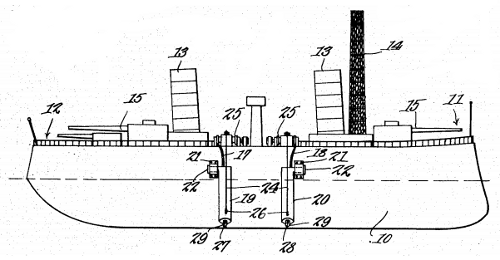
Here’s a simple way to deal with enemy submarines — hang giant electromagnets over the sides of your ship:
The magnets being projected outwardly from the ship’s sides, a submarine within the fields of the magnets is attracted and drawn thereto until the glass caps are struck by the submarine and broken. The contacts will now be against the submarine which will close the circuit through the submarine, lighting the lamp and ringing the signal bell, thus notifying the crew of the ship of the capture of the submarine. The submarine will also be electrified, shocking the crew thereof and killing or rendering them temporarily helpless.
Inventor Louis Schramm offered the scheme in 1914. I don’t know whether anyone tried it out. Let’s hope not.
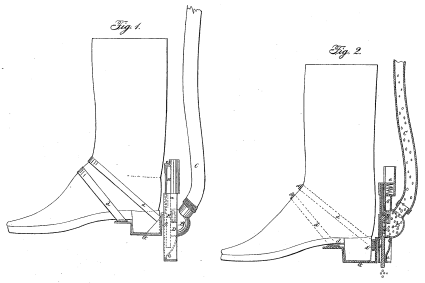
George Meacham invented this convenient planting device in 1856. Strap a seed bag to your waist and a plunger to each boot and you can plant corn effortlessly while strolling in your fields.
And maybe afterward you can dispense popcorn at the campfire.
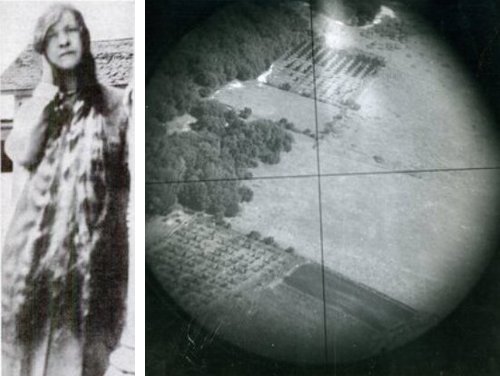
In 1943, Colorado broom factory worker Mary Babnik Brown saw an advertisement in a Pueblo newspaper soliciting blond hair, at least 22 inches long, that had not been treated with chemicals or hot irons. Brown had never cut her hair, which she combed twice a day and washed twice a week with pure soap. When her samples were deemed acceptable, she cut off all 34 inches and sent it in, considering this her contribution to the war effort, though “I cried for two months.”
At the time she was told that her hair would be used in meteorological instruments. It wasn’t until 1987, the year of her 80th birthday, that she learned that it had been used in the Norden bombsight, a top-secret instrument that guided bombs to their targets. Engineers had determined that fine blond human hair worked ideally in crosshairs, but the technology was a closely guarded secret, so the donors weren’t told how their contributions would be used. “I couldn’t believe it when they told me,” Brown said. “All I knew was that they needed virgin hair.”
She did get some compensation: Pueblo declared Nov. 22, 1991, “Mary Babnik Brown Day,” she was inducted into the Colorado Aviation Historical Society’s hall of fame, and Ronald Reagan sent her this letter:
